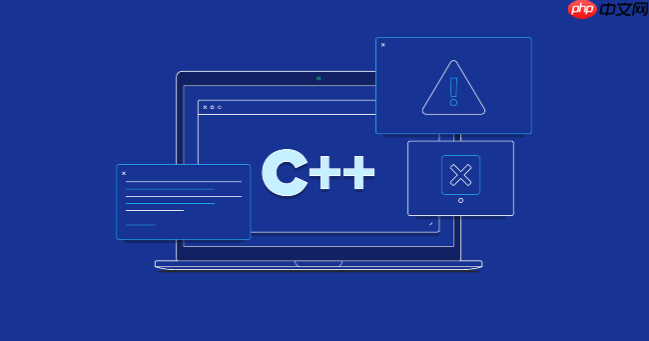std::function和std::bind是C++中处理回调和可调用对象的核心工具,前者提供统一接口封装各类可调用实体,后者支持参数绑定与重排,二者结合可灵活适配函数签名,尤其在处理成员函数回调时通过绑定this指针实现解耦,尽管lambda在现代C++中因更优的可读性常被优先选用,但std::bind在复杂参数适配等场景仍具价值。

C++中,
std::function
std::bind
std::function
std::bind
std::bind
在使用
std::function
std::bind
std::function
std::bind
std::bind
std::function
std::function
std::function
立即学习“C++免费学习笔记(深入)”;
#include <iostream>
#include <functional> // 包含std::function和std::bind
#include <string>
// 全局函数
void print_message(const std::string& msg) {
std::cout << "Global func: " << msg << std::endl;
}
// 带有返回值的全局函数
int add(int a, int b) {
return a + b;
}
class MyClass {
public:
void greet(const std::string& name) {
std::cout << "MyClass member func: Hello, " << name << std::endl;
}
int multiply(int a, int b) {
return a * b;
}
};
int main() {
// 1. 封装全局函数
std::function<void(const std::string&)> func1 = print_message;
func1("Hello from func1!");
// 2. 封装Lambda表达式
auto lambda = [](const std::string& msg){
std::cout << "Lambda func: " << msg << std::endl;
};
std::function<void(const std::string&)> func2 = lambda;
func2("Hello from func2!");
// 3. 封装带有返回值的函数
std::function<int(int, int)> func_add = add;
std::cout << "Result of add: " << func_add(10, 20) << std::endl;
// 检查是否为空
if (func1) {
std::cout << "func1 is not empty." << std::endl;
}
// 赋值为nullptr
func1 = nullptr;
if (!func1) {
std::cout << "func1 is empty now." << std::endl;
}
return 0;
}std::bind
std::bind
std::placeholders::_1, _2, ...
#include <iostream>
#include <functional> // 包含std::function和std::bind
#include <string>
// 再次定义之前的函数和类,为了代码的完整性
void print_message(const std::string& msg) {
std::cout << "Global func: " << msg << std::endl;
}
int add(int a, int b) {
return a + b;
}
class MyClass {
public:
void greet(const std::string& name) {
std::cout << "MyClass member func: Hello, " << name << std::endl;
}
int multiply(int a, int b) {
return a * b;
}
};
int main() {
MyClass obj;
// 1. 绑定全局函数,预设一个参数
// bind(print_message, "Fixed message") 会生成一个无参数的可调用对象
std::function<void()> bound_global_func = std::bind(print_message, "This is a fixed message.");
bound_global_func(); // 调用时不需要参数
// 2. 绑定带有返回值的全局函数,预设一个参数,另一个参数使用占位符
// std::placeholders::_1 表示这个位置的参数将在调用bound_add时传入
std::function<int(int)> bound_add_partially = std::bind(add, 100, std::placeholders::_1);
std::cout << "Result of bound_add_partially(20): " << bound_add_partially(20) << std::endl; // 100 + 20 = 120
// 3. 绑定成员函数:需要&类名::成员函数 和 对象实例(或指针)
// std::bind(&MyClass::greet, &obj, std::placeholders::_1)
// 第一个参数是成员函数地址,第二个参数是对象实例(或指针),后续是成员函数的参数
std::function<void(const std::string&)> bound_member_func = std::bind(&MyClass::greet, &obj, std::placeholders::_1);
bound_member_func("Alice");
// 4. 成员函数参数全部绑定
std::function<void()> bound_member_func_full = std::bind(&MyClass::greet, &obj, "Bob");
bound_member_func_full();
// 5. 参数重排:使用多个占位符
// 假设我们有一个函数 void process(int a, int b, int c);
// 但我们想调用时传入 (c, a, b) 的顺序
auto func_original_order = [](int a, int b, int c){
std::cout << "Original order: a=" << a << ", b=" << b << ", c=" << c << std::endl;
};
// 绑定时,我们希望传入的第一个参数给c,第二个给a,第三个给b
std::function<void(int, int, int)> reordered_func =
std::bind(func_original_order, std::placeholders::_2, std::placeholders::_3, std::placeholders::_1);
reordered_func(10, 20, 30); // 实际调用时,10 -> _1, 20 -> _2, 30 -> _3
// 结果是 func_original_order(20, 30, 10)
return 0;
}std::function
std::bind
std::function
在我多年的C++开发经历中,我发现很多人对这三者的选择常常感到困惑。它们确实都能表示可调用对象,但各自的侧重点和适用场景大相径庭。
函数指针,这是C语言时代就有的老朋友了。它本质上是一个地址,指向一个函数的入口。它的优点是轻量、直接,没有运行时开销。但它的局限性也很明显:
this
void(*)(int, int)
Lambda表达式,这是C++11引入的语法糖,但其影响力远超“糖”的范畴。它允许你在代码中直接定义一个匿名函数,最棒的是它能捕获周围作用域的变量(按值或按引用)。
auto
std::function
std::function<void(int, int)>
std::bind
std::function
std::function
为何选择它? 对我而言,选择
std::function
std::function
std::bind
std::bind
this
技巧:
绑定成员函数地址和对象实例: 这是最常见的用法。
std::bind
&ClassName::memberFunction
class Logger {
public:
void log(const std::string& message) {
std::cout << "[LOG] " << message << std::endl;
}
};
Logger myLogger;
// 绑定到具体的对象实例
std::function<void(const std::string&)> log_func = std::bind(&Logger::log, &myLogger, std::placeholders::_1);
log_func("Something happened."); // 调用myLogger.log("Something happened.")
// 如果你希望绑定到当前对象的成员函数(在类内部),可以这样:
// std::function<void(const std::string&)> self_log_func = std::bind(&Logger::log, this, std::placeholders::_1);这里使用
&myLogger
std::bind
myLogger
myLogger
std::ref
处理const
std::bind
const
std::function
const
class DataReader {
public:
void read_data() const {
std::cout << "Reading data (const method)." << std::endl;
}
};
DataReader reader;
std::function<void()> read_func = std::bind(&DataReader::read_data, &reader);
read_func();陷阱:
对象生命周期问题 (Dangling Pointer/Reference): 这是最常见也最危险的陷阱。当你将一个成员函数绑定到一个对象的指针或引用上时,
std::bind
std::function
std::function
std::function
// 错误示例:对象生命周期短于绑定的函数对象
std::function<void()> dangling_call;
{
MyClass temp_obj;
dangling_call = std::bind(&MyClass::greet, &temp_obj, "World"); // 绑定了temp_obj的地址
} // temp_obj 在这里被销毁了!
// dangling_call(); // 致命错误!访问已销毁对象的内存解决方案:确保被绑定的对象生命周期足够长。如果不能保证,考虑使用智能指针(如
std::shared_ptr
std::bind
std::shared_ptr<MyClass> shared_obj = std::make_shared<MyClass>(); std::function<void()> safe_call = std::bind(&MyClass::greet, shared_obj, "Safe World"); // shared_obj会被复制一份,增加引用计数 safe_call(); // 即使原始shared_obj超出作用域,对象也不会被销毁,直到safe_call也超出作用域
参数复制 vs. 引用:
std::bind
std::ref
std::cref
void modify_value(int& val) {
val += 10;
}
int x = 5;
// std::bind(modify_value, x) 会复制x,修改的是副本
std::function<void()> bound_copy = std::bind(modify_value, x);
bound_copy();
std::cout << "x after bound_copy (still 5): " << x << std::endl;
// 使用std::ref,绑定的是x的引用
std::function<void()> bound_ref = std::bind(modify_value, std::ref(x));
bound_ref();
std::cout << "x after bound_ref (now 15): " << x << std::endl;重载成员函数的问题: 如果一个类有多个同名但参数列表不同的成员函数(重载),
std::bind
class Calculator {
public:
int calculate(int a, int b) { return a + b; }
double calculate(double a, double b) { return a * b; }
};
Calculator calc;
// 编译错误:ambiguous overload for 'calculate'
// std::function<int(int, int)> func_int = std::bind(&Calculator::calculate, &calc, std::placeholders::_1, std::placeholders::_2);
// 正确做法:显式转换
using IntCalcFunc = int (Calculator::*)(int, int);
std::function<int(int, int)> func_int = std::bind(static_cast<IntCalcFunc>(&Calculator::calculate), &calc, std::placeholders::_1, std::placeholders::_2);
std::cout << "Int calc: " << func_int(5, 3) << std::endl;
using DoubleCalcFunc = double (Calculator::*)(double, double);
std::function<double(double, double)> func_double = std::bind(static_cast<DoubleCalcFunc>(&Calculator::calculate), &calc, std::placeholders::_1, std::placeholders::_2);
std::cout << "Double calc: " << func_double(5.0, 3.0) << std::endl;这在我看来是
std::bind
std::bind
这是一个非常好的问题,也是我在日常开发中经常思考和讨论的话题。我的观点是:在绝大多数情况下,尤其是在现代C++项目里,Lambda表达式确实可以(也应该)替代std::bind
std::bind
为什么Lambda通常更好?
std::bind
// 使用 std::bind
auto bound_func = std::bind(some_func, _2, 10, _1);
// 使用 Lambda
auto lambda_func = [&](int a, int b){ some_func(b, 10, a); };Lambda的意图一目了然,而
_1
以上就是c++++如何使用std::function和std::bind_c++函数封装与绑定器详解的详细内容,更多请关注php中文网其它相关文章!

c++怎么学习?c++怎么入门?c++在哪学?c++怎么学才快?不用担心,这里为大家提供了c++速学教程(入门到精通),有需要的小伙伴保存下载就能学习啦!

Copyright 2014-2025 https://www.php.cn/ All Rights Reserved | php.cn | 湘ICP备2023035733号